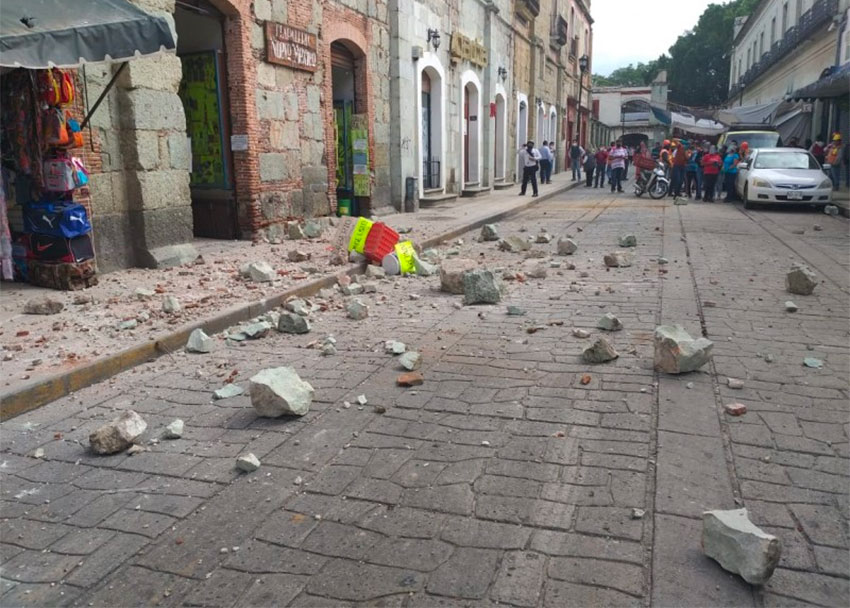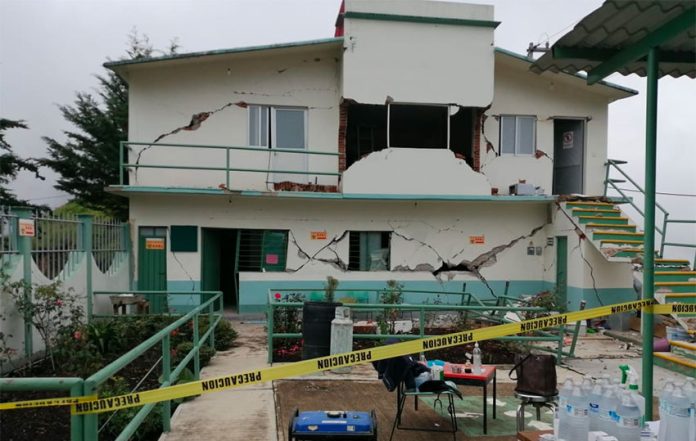A 7.5-magnitude earthquake that shook southern and central Mexico on Tuesday morning damaged more than 500 homes in Oaxaca and left six people dead, authorities said.
The Oaxaca government said in a statement that most of the affected homes only sustained minor damage, while Governor Alejandro Murat confirmed the deaths of five men and one woman as a result of the quake, whose epicenter was located 23 kilometers south of La Crucecita, a town in the tourist destination of Huatulco.
More than 30 people were injured during the earthquake, Mexico’s 16th most powerful on record.
Homes and other buildings were damaged in at least 30 municipalities in Oaxaca, the newspaper Reforma reported, including 13 in the Central Valleys region, eight in the Sierra Sur, five on the state’s Pacific coast, three in the Isthmus of Tehuantepec and one in the Mixtec region.
At least 15 hospitals and health care clinics in Oaxaca were damaged as were four schools. Three federal highways, five state highways and a bridge also sustained damage or were affected by landslides.
A landslide on a highway in the municipality of San Juan Ozolotepec trapped two workers who were subsequently freed and taken to hospital, Murat said.
The governor said Wednesday morning that all of the affected roads are now open to traffic.
Some 50 historical monuments also sustained damage as a result of the earthquake as did structures at the archaeological sites of Mitla, Dainzú, Lambityeco and Yagul.
In Huatulco, the fire hall sustained severe damage but firefighters continued to provide services to the local community on Tuesday.
A fire broke out at the Pemex refinery in the coastal city of Salina Cruz shortly after the quake but was quickly put out. Early reports said that a refinery worker died from burns after the earthquake triggered an explosion but the federal government said later that his death was the result of a fall from a five-meter-high structure.
The Oaxaca government said that 2,300 members of the military were deployed to respond to the earthquake, explaining that they assessed damage and removed rubble, among other tasks.

The earthquake hit Oaxaca the hardest but was felt in 11 other states: Mexico City, México state, Guerrero, Chiapas, Michoacán, Jalisco, Querétaro, Morelos, Tabasco, Veracruz and Puebla.
Hundreds of aftershocks have been reported since the quake struck at 10:29 a.m. Tuesday including one with a magnitude of 5.5.
The Federal Electricity Commission reported that the earthquake affected the supply of power to more than 2.6 million customers in several states.
While Oaxaca bore the brunt of the quake, damage was also reported in other parts of the country.
In México state, both the General Hospital in Chalco and an IMSS health care facility in Ecatepec sustained minor damage, while water supply to the municipality of Nezahualcóyotl was interrupted.
In Veracruz, the earthquake caused a phosphoric acid spill at an industrial plant in the port city of Coatzacoalcos, the newspaper Milenio reported.
In Mexico City, where the sounding of the seismic alarm sent residents rushing to the street to seek safety in the open air, two people were reportedly injured and 36 buildings sustained minor damage.
Mayor Claudia Sheinbaum said that four Mexico City government buildings were damaged. The worst damage occurred at offices of the water department, where a staircase became detached as a result of the powerful seismic waves that reached the capital from the quake epicenter about 700 kilometers away.
In the northern borough of Gustavo A. Madero, a five-story residential building sustained structural damage, forcing the residents of all 40 apartments to evacuate.
Yesterday’s temblor came almost three years after two powerful earthquakes devastated southern and central Mexico in September 2017.
Mexico is located within two active earthquake zones, making tremors a common occurrence and occasional temblors an unavoidable fact of life.
